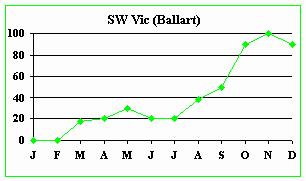
Pastures for Horses – a winning resource?
Angela Avery, Agriculture Victoria Rutherglen
Introduction
In Australia traditional feeding practices are based on concentrated feeding with pasture supplementation, in contrast to the successful New Zealand practice of pasture based feeding. While a shift to an entirely pasture based system is unlikely and not feasible in many environments in Australia, the nutritional role of pasture could be significantly increased, with concomitant savings in feeding costs.
Pasture scientists in Australia have largely ignored the horse industry and have concentrated their efforts on improving pasture for sheep and cattle. While research on pasture for horses has been documented for New Zealand, the USA, the UK, Belgium, France and Polland, progress in developing pasture systems for horses is being hampered by a lack of research, small horse numbers in research and unpublished information.
In this paper I will concentrate on the agronomic aspects of pastures in south-eastern Australia and discuss how to benefit from the Australian pasture resource.
Horses evolved to graze
Paleontologists believe the horse evolved on the North American continent as a leaf-browsing mammal. During the Miocene epoch, the ancestors of the horse changed their method of feeding from browsing leaves to grazing grass as the land changed gradually from forest to plains. In their natural habitat horses select grasses, clovers and herbs and then move to new areas. They can travel up to 16 km a day and sometimes may never return to the same area to graze.
Horses have an adaptive digestive system that enables them to utilise a wide range of feeds.
The stomach of the horse is small and well designed for continuous eating. It has no storage capacity, no gall bladder and bile is continually released into the gut. The caecum is a very large pouch, 20 to 30 litres in volume that has been highly developed for microbial breakdown of fibrous material. Horses grazing pasture rarely develop sharp edges on their teeth.When possible, horses will spend a significant proportion of their time grazing, Gallagher & Hughes (1993) observed that racehorses grazing perennial ryegrass spent between 16 and 18 hours a day or 72% of their time grazing. The exact length of time is
dependant on pasture quantity, quality and the level of supplementary feeding. Time spent grazing has been shown to be a heritable trait.The benefits of pasture
Pasture can offer the standardbred industry several benefits:
Nutrition
Pastures play a pivotal role in equine diets. While the diet of the standardbred racehorse in training is unlikely to include pasture, in most cases this horse would have been bred, raised and spelled on pasture.
There have been a limited number of studies undertaken to evaluate whether pasture alone will meet nutritional requirements at different stages of lactation and growth. McLaughlin and McKiernan (1986) observed that in the Hunter Valley in Australia good growth could be achieved by foals grazing quality improved pasture without the need for supplements in energy and protein. McMeniman et al. (1990) observed good growth of mares and foals on sub-tropical, semi-improved pasture. On a similar pasture, McMeniman (1988) also observed that pregnant mares could be maintained without the need for supplementation (growth 35 kg.head from July to October). Martin (1993) calculated that the nutrient intake of these mares were in excess of NRC (1989) requirements on all but two occasions (November crude protein was deficient; October energy and protein was deficient).
Forage crop feeding of a 100 head standardbred brood mare herd at UWS, Hawkesbury in 1986 proved feasible and less costly than the previous concentration feeding system (Kelleher, 1987, unpublished). Avery et al. (unpublished) measured growth rates of thoroughbred weanling fillies to be 0.79 kg.day and 0.71 kg.day on improved and unimproved pasture respectively in 1998.
Freeman et al. (1987) measured a moderate growth rate (0.59 kg.day) from yearling horses grazing lucerne without supplementation in the USA. Studies with Bermuda grass (Cynodon dactylon) have shown that pastures base upon this species could only support low to moderate growth rates from 0.25 to 48 kg.day (Aiken et al. 1989).
General Health
Feeding horses at pasture can result in fewer medical problems such as colic and "tying-up". It also allows for exercise and social interaction.
Productive persistent pastures will maintain ground cover and minimise dust. This has the potential to reduce the incidence of "ratttles" and other respiratory diseases. Pasture will also provide a soft ground surface in summer to cushion galloping horses to minimise undue strain and concussion of limbs and a less "pugged" and drier ground surface in winter.
Aesthetics
For the stud industry enterprise appearance is an important element in client satisfaction. The majority of clients expect to see their horses in green weed-free pasture. This expectation is a key reason why leading studs invest in pasture establishment and management.
Economics
The Australian stud industry to date has shown a reluctance to shift its feeding base from high-cost concentrates to pastures. However, due to economic pressures there is now a trend toward greater reliance on pasture in response to economic pressures. Pasture is an inexpensive feed source, a fact recognised by other grazing industries.
Environment
As with all agricultural industries, the horse industry will need to become more aware of the environmental impacts of their activities. This pressure will be particularly strong in rural-urban fringe areas. Weed invasion, soil erosion and nutrient runoff are all likely to be issues, with some local Government bodies moving towards maximum stocking rates for certain areas. Well-managed perennial pastures will play a significant role in addressing these concerns.
The pasture base
Most temperate Australian pastures are made-up of legumes and grasses. The most frequently grown legumes are clovers and lucerne. Legumes are important as they have higher levels of digestible protein and greater concentrations of calcium compared to grasses and therefore significantly increase the nutritional value of pasture. Unlike grasses, clovers convert nitrogen from the air to a form that plants can use. Legumes are only able to provide nitrogen in the presence of soil rhizobia. Compared with legumes, grasses have greater year-round production, provide more feed in late autumn, winter and early spring and have a greater tolerance to grazing.
Horse pastures should contain between 20 to 30% legumes on a dry weight basis. Lower levels of legume in the pasture will reduce nutritional value and pasture growth. Levels greater than 40% can cause scouring and young horses to grow quickly, which can result in DOD. Wherever possible pasture should contain perennial species. The higher the portion of perennials in the pasture the better.
Pasture quantity
Both the quantity and quality of pasture will determine the performance of horses. To develop sound rations, pasture quality and quantity must be assessed.
The quantity of pasture in a paddock, that is, all the herbage above the ground, is referred to as herbage mass and is measured in kilograms of dry matter per hectare (DM kg.ha). Pasture varies in its moisture content and needs to be converted to dry matter values for comparisons. It is also important to know what proportion of the herbage is green and dead as this has an important influence on how well horses do on pasture.
After some practice pastures can be "eyeballed" to estimate the amount of herbage in both height and DM kg.ha. A simple technique is to use a pasture stick that measures pasture height, which can then be related to total herbage mass. A general height conversion to dry matter has been provided in figure 1. Conversions may need to be developed for local pasture and environments.
Pasture
HeightPasture Herbage
massheight (pasture quantity)1.0 cm 500 kg/ha green pasture 2.0 cm 800 kg/ha green pasture 3.0 cm 1100 kg/ha green pasture 4.0 cm 1400 kg/ha green pasture 5.0 cm 1700 kg/ha green pasture Based on perennial ryegrass at Hamilton Vic
Figure 1: Estimation of green pasture mass from pasture height
Pasture growth
Figure two provides average pasture growth rates for different regions in Victoria and NSW.
Figure 2: Pasture growth rates kg.ha.day

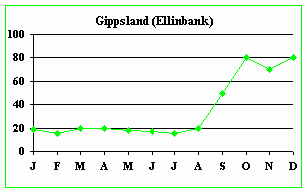
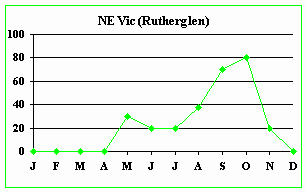
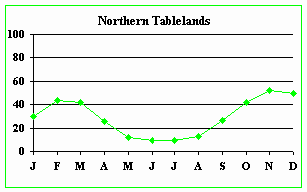
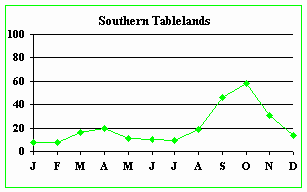
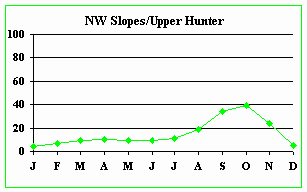
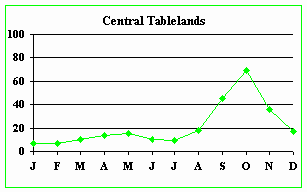
Figure 2: Pasture growth rates kg.ha.day
Pasture quality
There is no single way to determine pasture quality. Factors used to estimate pasture quality range from paddock assessment of clover and percentage green of the pasture to laboratory testing that determines protein, energy, digestibility and fibre. At present most commercial laboratories in Australia are based on ruminant (cattle and sheep) digestion.
Digestibility is the amount of pasture eaten retained by the horse. If green pasture has a digestibility of 75%, 75% of what the horse eats will be used, while the remaining 25% will pass out as waste. Feed of a higher digestibility will be digested more rapidly allowing most animals to eat more feed, this relationship needs to be better defined for horses.
There are many factors that can assist in making a judgement as to the quality of a pasture.
Species in the pasture: Pasture species vary in digestibility (Table 1and 2). As a general rule white clover, lucerne and Persian clover are more digestible than grass species, which are similar to sub clover. The differences in the digestibility between annual and perennial grasses appear towards the end of the season when annual grasses quickly loose quality as they become reproductive. Perennial grasses maintain some quality feed into summer especially with summer rainfall and when the flowering stage is delayed.
Table 1: The quality of different pasture species in the middle of the growing season
|
Digestibility group |
Pasture species |
|
Very high |
White clover, Persian clover |
|
High |
Perennial ryegrass, phalaris, tall fescue, lucerne, capeweed, sub and balansa clover |
|
Moderate (60-70%) |
Cocksfoot, soft brome and barley grass Wallaby grass and fog grass |
|
Low |
Onion grass, sweet vernal, spear, weeping, kangaroo and silver grass. |
Table 2: Crude protein, digestibility and energy of different pasture species
|
Pasture species/variety |
Crude protein |
Digestible dry matter (%) |
Energy |
|
|
Autumn Growth |
||||
|
Sirosa phalaris |
15.3 |
64.5 |
9.7 |
|
|
Sirolan phalaris |
16.2 |
67.8 |
10.1 |
|
|
Australian phalaris |
15.0 |
66.0 |
9.9 |
|
|
Currie cocksfoot |
18.1 |
64.5 |
9.7 |
|
|
Demeter tall fescue |
15.1 |
64.3 |
9.6 |
|
|
Victorian P. ryegrass |
15.6 |
69.2 |
10.4 |
|
|
Winter Growth |
||||
|
Sirosa phalaris |
13.8 |
57.0 |
8.6 |
|
|
Sirolan phalaris |
13.8 |
59.0 |
8.9 |
|
|
Australian phalaris |
13.8 |
61.0 |
9.1 |
|
|
Currie cocksfoot |
16.8 |
62.0 |
9.4 |
|
|
Demeter tall fescue |
13.8 |
61.0 |
9.2 |
|
|
Victorian P. ryegrass |
15.0 |
65.0 |
9.8 |
|
Amount of dead herbage in the sward: Green pasture is always more digestible (55-85% digestibility) than dead pasture (35-65% digestibility) of the same species. Pasture is the highest quality early in the vegetative stage and gradually declines as the pasture ages.
Pasture growth stage: Large quantities of dead herbage mixed with green can significantly reduce the nutritive value of a pasture. Horses are selective grazers, but will be forced to eat dead grass while foraging out green grass. As a consequence the overall quality of their diet is less. This frequently occurs during autumn when pasture from the previous season has not been grazed. When assessing and sampling pasture for analysis, the green and dead components need to be separated.
Parts of the plant: In most plants leaves are of higher quality than stems. The difference is largely dependent upon "woodiness" of the stem. The digestibility difference between the stem and the leaf of lucerne is between 10 and 15%. The stem and the leaf of sub clover are similar in quality.
Pasture species
Perennial Ryegrass (Lolium perenne): Perennial ryegrass is a premium feed because of its high digestibility. Rainfall and the severity of summer conditions govern where perennial ryegrass can be grown. In areas that experience hot dry summers, such as north-east Victoria and southern NSW, perennial ryegrass is unlikely to persist with less than 700 mm annual rainfall. However, in regions with cooler and/or wet summer conditions perennial ryegrass will grow when the annual rainfall is above 600 mm. Soils should be high in fertility and of medium to heavy texture.
Perennial ryegrass contains endophyte, a fungus that lives in the ryegrass plant. Endophyte has been shown to cause "ryegrass staggers" in horses in New Zealand. Ryegrass staggers is a nerve and muscle disorder that causes horses to tremble. They are unable to move and can fall down. It is not usually fatal and affected horses normally recover when offered non-toxic feed.
Tall Fescue (Fescue arundinacea):
Tall fescue is a perennial grass suited to regions that receive above 600 mm of annual rainfall. Tall fescue is suited to medium-heavy textured soils and tolerates wet, acidic and moderately salted soils. Tall fescue is slow to establish, sensitive to grazing until properly established and is less productive than other perennial grasses in winter but will grow in spring, summer and autumn when there is adequate moisture. New varieties of tall fescue will soon be available with improved winter production and palatability. Tall fescue is highly nutritious and compares favourably with perennial ryegrass.Phalaris (Phalaris aquatica): Phalaris is a perennial grass that is grown in areas too hot and dry for perennial ryegrass (less than 700 mm annual rainfall). Phalaris is suited to heavier soils and will tolerate waterlogging. It will not tolerate high levels of aluminium commonly associated with acid soils. Phalaris seedlings are not vigorous and cannot withstand competition from weeds or more vigorous pasture species. It is productive over the autumn, winter and spring periods. Persistence problems experienced in some eastern states have been attributed to soil fertility, acidity and grazing management. Phalaris stems need to be allowed to elongate in spring to form dormant buds at the base of the plant. These buds allow phalaris to survive over summer. This is particularly important with a newly sown phalaris pasture. Alkaloids in phalaris can cause sudden death and phalaris staggers in sheep during the autumn and winter when phalaris is the dominant species. Effects on horses are uncommon in Australia.
Cocksfoot (Dactylis glomerata): Cocksfoot is more drought tolerant than perennial ryegrass but less tolerant than phalaris and requires a minimum of 450 mm annual rainfall. It is well suited to light-textured soils with low moisture holding potential. Cocksfoot will not tolerate waterlogging, is slower to establish than perennial ryegrass and is less nutritious than perennial ryegrass and phalaris. The lower nutritive value and palatability of cocksfoot means that it is normally grown where perennial ryegrass and phalaris will not persist well or in a mixture with one of the other perennial grasses. European types of cocksfoot have the greatest potential for summer growth. Without adequate follow-up rainfall, intermittent bursts of growth can use up stored food reserves and kill out a large percentage of the plants. Cocksfoot does not contain animal toxins and it has few serious pests and diseases. Cocksfoot pastures tend to form tussocks through poor grazing management and can severely restrict clover development.
Subterranean Clover (Trifolium subteranneum): Subterranean clover is an annual pasture legume that is grown in most pastures in southern Australia. To maintain clover in the pasture it is vital that plants are allowed to set seed each year. Varieties vary in the time they mature, those that mature early tend to be less productive. The variety selected must flower and complete seed development while there is sufficient soil moisture. The lower the annual rainfall the earlier the variety of clover sown. Clovers also have different levels of hard seed. These levels are important as they protect against the depletion of the seed stored in the soil by summer storms, false autumn breaks and dry springs. In districts with reliable autumn and spring conditions satisfactory production and persistence will be achieved from the late maturing varieties. Conversely, in districts with short and unreliable growing seasons, early to mid season varieties of sub clover should be sown. Some varieties of sub clover have special features for example, the sub species Trifolium yanninicum or white seeded clovers (Trikkala, Larisa and Gosse) will better tolerate wet winter soils than other groups of sub clover.
White Clover (Trifolium repens): White clover is a perennial legume suited to regions that receive an annual rainfall above 750 mm or irrigation. It is easy to establish and has a prostrate growth habit, with the stems forming runners that spread across the soil surface and take root at the nodes. White clover grows most vigorously when conditions are mild. It will not grow well in cold winters and will die off during long, hot dry periods. Stolons can survive short dry spells even after the top growth has died off. When white clover plants die, regeneration is dependent on the seed reserves built up in the soil. In marginal regions white clover is often worthwhile in a pasture even when it may only persist for a few years. White clover will grow over a wide range of soil types and fertility levels and is capable of high production (mainly spring, summer and autumn) when fertility is high. Persistence can be enhanced by maintaining vegetative cover and by reducing grazing pressure over dry periods. The smaller leaved varieties tend to be more persistent under drier conditions and harder grazing. White clover contains cyanogenic glycosides that potentially can cause prussic acid (cyanide) poisoning. Levels are frequently low and are unlikely to cause animal health problems. Varieties with low cyanogenic levels are generally preferable in horse pastures.
Ecology of horse pastures
The classic picture of mature horse pastures is one of heavily grazed areas (lawns) interspersed with rank, ungrazed areas (roughs) where horse defecate and urinate. Further areas may be bare, due to traffic or congregation around water troughs, in rest areas, or along fencelines. Such pastures are described as being "horse-sick" and are a function of horse confinement, stocking intensity, grazing behaviour and pasture management practices (Archer 1978b, 1980; Goold 1991 a, b). The deterioration of an initially uniform and stable pasture to this state results largely from the grazing behaviour of the horse.
Grazing behaviour and patterns
Horses have a grazing behaviour and physiology that enable them to be extremely selective in what they consume (Archer, 1973b, 1978a, b, 1980; Elphinstone, 1981; Foyle, 1994, and Goold 1991a, d). Horses have a narrower bite than cattle, and their sharp teeth enables selective grazing to ground level ((Goold 1991 a). This grazing behaviour has a large impact on the botanical composition of pasture.
Defaecation patterns are a primary cause of the development of horse-sick pasture. Stallions approach a manure pat, smell it, turn around, and manure on top of it. Paddocks containing stallions tend to have several large piles of manure. Mares also approach and smell manure, they however manure without turning around and as a consequence manure patches become progressively larger. Geldings appear to be less particular as to where they manure. In contrast, other animals such as cattle, do not have special manure places and drop their dung haphazardly throughout the grazing process.
As a result of this defaecation pattern there is a significant transfer of nutrients (phosphorus and potassium) to the rough areas (Kelleher and Johnston, unpublished). The combined effect of grazing avoidance and increased fertility results in tall rank pasture that is unpalatable. In a study in Belgium, Odberg and Francis-Smith (1996), showed that 51% of a paddock grazed by standardbred mares and geldings was made up of roughs and not grazed. This effectively doubled the stocking rate on the grazed pasture.
Weed ingress
Changes in pasture composition as a result of horse grazing are likely to occur. Continuous low grazing in lawn areas will threaten the persistence of perennial grasses and hence weaken the sward making, weed invasion possible. In the rough un-grazed areas more prostrate species such as clover are likely to be shaded-out and high-fertility weeds such as capeweed will dominate and compete with favourable species. Weed invasion of horse pastures is aggravated by the inability of the horse digestive system to render common weeds un-viable unlike cattle and sheep (Rodriguez et al., 1983).
Soil effects and land degradation
Horses create bare areas through heavy traffic and physical impact in camp areas around water troughs and fencelines. These areas become compacted, concentration lines for water in wet weather, leading to erosion and nutrient loss. The degree of damage is determined by a number of factors including; soil type, stocking rate, paddock size (square paddocks influence grazing behaviour and speed and turning when the horse is exercising) and the presence of companion grazers (Japanese research with thoroughbred yearlings showed that in a 7 hour grazing period, a lone yearling walked between 8 and 15 km (Kusunose et al, 1986) compared to 5 km within a group (Kusunose et al, 1986).
Pasture managementGrazing/topping
The most common grazing management strategies are continuous grazing or a period of grazing following a period of spelling (rotational grazing).
The deleterious effects of grazing horses on pastures may be delayed by rotational grazing. A number of rotational grazing systems have been developed for sheep and cattle, these include block, crash, mob, strip, cell and time-controlled grazing. While some of these grazing systems are unlikely to be appropriate for horses, they may be useful on enterprises where cross-grazing with sheep or cattle is being practiced.
Continuously grazed
paddocks are frequently overgrazed in winter or under grazed in spring, depending on the growth pattern of pasture. Pasture utilisation is poor and productivity is well below its potential in these situations. Grazing tends to be uneven and horses become more selective in what they eat, which allows the least-preferred species to dominate. Paddocks become worm infested and can move rapidly towards a state of "horse-sickness". Annual grasses tend to be favoured by continuous grazing in winter, and perennial legumes (white clover) are likely to be more disadvantaged by continuous grazing over summer. Continuous grazing systems are however perceived as the simplest and the most economic.Rotational or controlled grazing systems occur when grazing is followed by a period of rest. The length of this rest is normally determined by the regrowth rate of pasture. The theory is that rotational grazing systems are potentially better at increasing seasonal pasture availability and controlling quality to better match nutritional requirements. The rotation length allows for the development of adequate leaf areas in the pasture to ensure optimum pasture production.
Rotational grazing will also slow the rate at which a paddock becomes "horse-sick". Rotational grazing is difficult on horse enterprises due to the need to keep different genders and ages separate which limits paddock options, as well as the increased risk involved in moving horses into new paddocks.
Mixed grazing or cross-grazing is the grazing of other types of stock with horses. Fence damage is the primary reason why horse enterprises do not cross-graze. Cross-grazing offers large advantages for pasture and hygiene management and needs to be considered by all horse enterprises. Potential advantages include; increased efficiency of grazing, better manipulation of pasture composition, reduced parasite burden, more efficient nutrient cycling and avoidance of "horse-sick" pasture. Cattle or sheep can either precede, follow or graze with horses. The best option is for stock to follow horses as this gives horses first access to high-quality feed and forces cattle to graze the less palatable pasture that has been left behind. Cattle may however precede horses when the pasture quantity, or quality, is too high for horses.
Steers are preferred over sheep as they are less selective, they prefer longer grass than horses and they are easy to control with electric fencing. Cows and heifers will also do a good job, but can remove higher levels of calcium and phosphorus for bone growth and milk production. Research to quantify the gains of mixed grazing with horses is very limited, however gains between 12 to 16% seem realistic. Cattle will not graze around their own manure but will graze around horse manure. Cattle manure can disguise the smell of horse manure and increase grazing by horses in areas that were previously rejected. Horses prefer to graze shorter pasture than cattle and cattle will select tall pasture that has been avoided by horses.
The control of parasites by mixed grazing is questionable. Cattle initially select the upper layers of pasture, where few equine parasite larvae reside. The quantity of larvae ingested by horses per unit of dry matter could therefore be greater once the taller pasture has been eaten. Alternating grazing ruminants (sheep, cattle or goats) and horses may be more effective than mixed grazing in reducing parasite loads if the periods between grazing are long enough so that parasite larvae die. There is the potential to increase Trichostrongylus axel infection as horse cattle; sheep and goats share this parasite.
Topping and mulching
are the removal of excess pasture by mechanical equipment (mowers, slashers, and mulchers). Topping will remove poor quality clumps of pasture, which recover and grow pasture of improved quality that is more palatable to horses. Mulching differs from topping in that the pasture is cut numerous times to leave a finely chopped residue. Benefits of mulching include the ‘thatching-out’ of old grass, enhanced clover growth and the build up of organic matter.Topping and mulching are carried out for several reasons.
In a rotational grazing system after the grazing of either horses or cattle/sheep to remove unpalatable pasture, avoiding the onset of "horse-sick" pastures and ensuring that at the next grazing the best possible pasture is available.
To delay the onset of the plant’s reproductive phase and the associated decline in pasture quality. In spring and early summer many ryegrass tillers show reproductive growth. During this time growth is rapid, resulting in stemy growth and finally a seed head. This first occurs around manure patches.
Topping to control reproductive development should be carried out when the seed head is just beginning to emerge to ensure the removal of the growing point. Pasture must be cut to a height that removes the growing points and kills the reproductive tillers (4 to 5 cm). Topping will stop further reproductive growth and a new tiller of greater quality grass will grow. If the growing point is not removed the plant will continue to grow and produce a seed head. The topping of phalaris pastures can jeopardise plant persistence in some regions.
The prevention of seed set of annual weeds by topping can significantly reduce their prevalence in the following year. Topping will have only a limited effect on prostrate weeds.
Fertilisers
Fertiliser management is complicated by a lack of information on the nature, rates, patterns and magnitude of nutrient fluxes in horse pastures and effective fertiliser management strategies to counteract pasture degradation. Current recommendations are based on research of cattle and sheep.
All fertiliser strategies should be based upon soil tests and soil samples should be taken from the preferred grazing areas (lawns) to ensure fertiliser needs are not distorted by the high values in the rough areas of the paddock.
Soil acidity describes the current acid status of a soil and is measured on a pH scale. The term CaCl2 after the pH figure signifies that the pH was measured in a solution of calcium chloride, a test preferred by most soil scientists. pH tested in CaCl2 is 0.5 to 0.8 lower than if tested in water. Soil test results will usually have the soil pH figure expressed in water and calcium chloride. A strongly acid soil has a pH < 4.5 (CaCl2) or pH 5.3 measured in water.
Lime (calcium carbonate) or dolomite (calcium and magnesium carbonate) will raise soil pH and can increase pasture production. The quality and effectiveness of lime depends on the chemical purity of the product and its ability to react quickly with the soil. Pure calcium carbonate (limestone) with a neutralising value of 100 is the standard against which other liming materials are measured. The most important factor to consider when assessing lime is the product's Effective Neutralising Value (ENV).
Phosphorus is one of the major plant nutrients in the soil. Most soils are naturally low in phosphorus due to excessive weathering. For pasture, generalised ranges for Olsen P in 0 to 10 cm surface soils are shown in Table 3. These Olsen P values only provide a guide because the interpretation of the test results are modified to account for soil texture, rainfall, pasture species and paddock management.
Table 3 : Interpreting Olsen P soil test results
|
Olsen P |
Dryland Pastures |
Irrigated Pastures |
|
Low |
less than 8 |
less than 12 |
|
Marginal |
8 to 12 |
12 to 18 |
|
Moderate |
13 to 18 |
19 to 25 |
|
High |
more than 18 |
more than 25 |

Weed management
Weed control in horse pastures is best managed by preventing infestation through the maintenance of productive persistent perennial pastures, rather than to rely upon eradication. In most situations weeds can be controlled by herbicides, however such herbicides can weaken non-target species, rely upon spray-grazing techniques which, while not tested, are likely to inappropriate for horses. The best non-chemical control for weeds in the Hawkesbury area was identified as slashing followed by sheep grazing.
Paddock management plan
Pasture height
= 15 cm
Pasture height = 5 cm (uneven) Horses out cattle in (if available) and or mulch Pasture height = 5 cm (even)
Spell paddock |
References
Aiken, G.E., Potter, G.D., Conrad, B.E. and Evans, J.W. (1989). Growth performance of yearling horses grazing bermuda grass pastures at different grazing pressures. Journal of Animal science 67: 2692-2697.
Archer, M (1978a). Further studies on palatability of grasses to horses. Journal of the British Grassland Society 33: 239-243
Archer, M (1978b). Studies on producing and maintaining balanced pastures for studs. Equine Veterinary Journal 10: 54-59.
Archer, M. (1980). Grassland management for horses. The Veterinary Record 107: 171-174
Elphinstone, G.D. (1981). Pastures and fodder crops for horses in southern coastal Queensland. Queensland Agricultural Journal 107: 122-126.
Freeman, D.W., Topliff, D.R., McCollum, F.T., Pumphrey, J.E, Altom, W. and Griffith, C.A. (1987). Preliminary investigations of grazing horses on alfalfa. Nutrition-Abstracts-and-Reviews Series B 1988 058-01239.
Foyel, J. (1994). Hoofprints. A Manual for Horse Property Management. Primary Industries South Australia 1994 AGDEX 461/10 90 pp.
Gallagher, J.R. and McMenamin, N.P. (1988). The nutritional status of pregnant and non-pregnant mares grazing South East Queensland pastures. Equine Veterinary Journal, London 20: 414-416.
Goold, G.J. (1991a). Problems of pasture management. Proceedings of the Equine Nutrition Seminar, Nutrition Society of Australia, Canberra 1991 : 115-116
Goold, G.J. (1991b). The mineral content of Waikatao thoroughbred horse pastures: 1. Major elements Proceedings of the Equine Nutrition Seminar, Nutrition Society of Australia, Canberra 1991 : 119-124
Goold, G.J. (1991d). Pasture management on small farms grazing horses. Proceedings of the Equine Nutrition Seminar, Nutrition Society of Australia, Canberra 1991 : 135-139
Kelleher, F.M. (1984). Pastures for the breeding herd – a case study. Unpublished paper to Horse Management Seminar, Hawkesbury Agriculture College, 984.
Kelleher, F.M. (1987). Pastures for the breeding herd Proceedings of the Horse Management Seminar, Hawkesbury Agriculture College, 1987: 44-71.
Kusunose, R., Hatakeyama, H., Ichikawa, F., Kubo, K., Kiguchi, A., Asai, Y. and Ito, K. (1986). Behavioural studies on yearling horses in field experiments. 2. Effect of group size on the behaviour of horses. Bulletin of the Equine Research Institute 23: 1-3.
Kusunose, R., Hatakeyama, H., Ichikawa, F., Kubo, K., Kiguchi, A., Asai, Y. and Ito, K. (1987). Behavioural studies on yearling horses in field experiments. 3. Effect of pasture shape on the behaviour of horses. Bulletin of the Equine Research Institute 24: 1-5.
Martin, R.G. (1993). Effects of nitrogen and energy supplementation on grazing broodmares and aspects of nitrogen metabolism in horses. PhD Thesis, The University Of Queensland.
McLaughlin, B.D. and McKiernan, W.A. (1986). Factors affecting the weight of suckled foals.. Proceedings of the Australian Society of Animal Production. 16 : 421
McMenamin, N.P,, Martin, R.G, and Dowsett, K.F. (1990). Intake studies with grazing horses. Proceedings of the Australian Society of Animal Production 18 : 112-114.
Odberg, F.O. and Francis-Smith, K. (1997). A study on the formation of ungrazed eliminative areas in fields used by horses. Applied Animal Ethology 3 : 27-34.
Rodriguez-B, J.I., Paz, O. and Verdecia-G, J.L. (1983). Study of possible agents in the dissemination of weed seeds. Weed Abstracts 1986 056-00602.
|
|
|
|
|
|
|
|
|